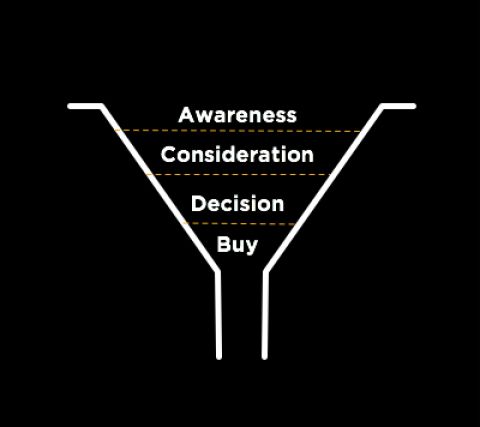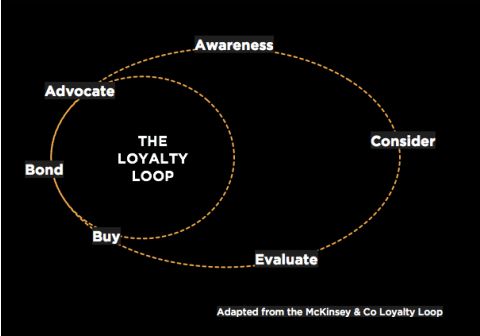Top of the toolkit list for digital marketing strategy for the team at Brilliant Noise is the Loyalty Loop, a model devised by McKinsey & Co as an alternative to the traditional sales funnel.
Since we read about it early last year, the Loyalty Loop has figured large in our work with clients, as well being a theme we have returned to often in conference talks and the like.
Ye olde sales funnel model
Sales and marketing has used the idea of the sales funnel for decades now. It looks like this:

And it works like this:
For people to buy your product or service they need to pass through the following stages:
1. Awareness: they’ve heard of it.
2. Consideration: They are thinking about buy it, and maybe some alternatives from your competitors.
3. Decision: The “moment of truth” they go to the store, pick up the phone, fire up the website and decide to buy…
4. Purchase: Click, ker-ching, yes… they’ve bought it. Hand them over to whoever fulfillls the order in your organisation. The bell rings, the champagne corks pop and the sales and marketing machine swivels its attention back to getting more attention.
How the Loyalty Loop works
The obvious issue, accentuated by the growth of the web and new communications channels, is that this ignores the opportunity to develop loyal customers who will also deliver the most powerful brand message of all: a personal recommendation.
McKinsey proposed a new model, the Loyalty Loop, which looks a bit like this…

I say “a bit like this” as when I returned the original article to write this post I realised that we had become so comfortable with it that we’d tweaked it slightly. We added the “awareness” part, and also have been switching round “Bond” and “Advocate” as that seems to flow better…
Anyway, it works like this:
McKinsey calls it the Consumer Decision Journey (although we’ve used it as a Stakeholder Decision Journey for non-consumer audiences and it can be just as useful)…
1. Awareness: The consumer is aware of the product or service.
2. Consider: They begin to think about a purchase.
3. Evaluate: They form a short-list or make a provisional decision and being to test it, asking friends, looking for reviews etc.
4. Buy…
5. Bond: If they have positive experiences of the thing they have purchased, including any support with problems and after-care, they begin to bond with it…
5. Advocate: If they have bonded with the brand and trust it they will recommend to it their friends. At this point, if they decide to make a repeat purchase or a similar item or service they are likely not to go back out to look for alternatives.
What it means for marketers
The Loyalty Loop model and the consumer decision journey concept allow us to re-balance our resources in marketing. The HBR article by McKinsey I mentioned above is called Branding in the Digital Age: You’re Spending Your Money in All the Wrong Places. The challenge thrown out to marketers is to look at their consumer’s decision journey and look at the role that different media and “touch points” (including packaging, customer service and even product documentation) play throughout that journey.
Mapping where the marketing spend goes by percentage across those media and consumer journey stages can be sobering. Most goes of course on advertising in the awareness phase.
McKinsey’s Edelman also suggests that CMOs take action in three ways:
- Owning the customer experience, including the customer care, packaging etc.
- Having a view of the data about the consumer experience throughout the journey, becoming a “Marketplace Intelligence Leader”.
- Developing a “Content Supply Chain” – a great phrase – to ensure that content is efficiently procured, distributed and is consistent throughout the consumer experience.
* Other funnel alternatives are available
To find out more about this model I highly recommend buying or getting access to the Harvard Business Review article by McKinsey & Co’s marketing lead, David C Edleman. If you have to buy it I assure you it is worth investing in owning a copy.
This explains things in more depth and provides case studies, including Apple, whose after-care (generous Genius Bars and no-questions-asked replacements for faulty products being just one example) and product experience has tied me personally into that Loyalty Loop.
It is worth noting that other people have also put forward very useful and valid alternatives to the funnel. Most notably, Forrester have been heralding the “death of the funnel” for some time. We especially liked Steven Noble’s post It’s Time to Bury the Marketing Funnel.
Get in touch if you’d like to know how we can help you visualise your consumer decision journey and transform your marketing.
